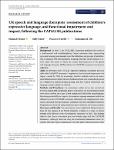UK speech and language therapists’ assessment of children's expressive language, and functional impairment and impact, following the CATALISE publications
| dc.contributor.author | Waine, H | |
| dc.contributor.author | Bates, S | |
| dc.contributor.author | Frizelle, P | |
| dc.contributor.author | Oh, Tomasina M | |
| dc.date.accessioned | 2023-08-03T09:22:43Z | |
| dc.date.available | 2023-08-03T09:22:43Z | |
| dc.date.issued | 2023-04-27 | |
| dc.identifier.issn | 1368-2822 | |
| dc.identifier.issn | 1460-6984 | |
| dc.identifier.uri | https://pearl.plymouth.ac.uk/handle/10026.1/21147 | |
| dc.description.abstract |
Background: In 2016/17, the CATALISE Consortium published the results of a multinational and multidisciplinary Delphi consensus study, representing agreement among professionals about the definition and process of identification of children with Developmental Language Disorder (DLD) (Bishop et al.,2016, 2017). The extent to which the current clinical practice of UK speech and language therapists (SLTs) reflects the CATALISE consensus statements is unknown. Aims: To investigate how UK SLTs’ expressive language assessment practicesreflect the CATALISE documents’ emphasis on the functional impairment andimpact caused by DLD, by examining: whether multiple sources of assess-ment information are gathered; how standardised and non-standardised sources are combined in clinical decision-making, and how clinical observation andlanguage sample analysis are utilised. Methods and Procedures: An anonymous, online survey was carried out between August 2019 and January 2020. It was open to UK-based paediatric SLTs who assess children up to age 12 with unexplained difficulties using language. Questions probed different aspects of expressive language assessment which are referred to in the CATALISE consensus statements and supplementary comments, and asked about participants’ familiarity with the CATALISE statements. Responses were analysed using simple descriptive statistics and content analysis. Outcomes and Results: The questionnaire was completed by 104 participants, from all four regions of the United Kingdom, working in a range of clinical settings with different levels of professional experience of DLD. The findings indicate that clinical assessment practices broadly align with the CATALISE statements. Although clinicians carry out standardised assessments more frequently than other types of assessment, they also gather information from other sources and use this alongside standardised test scores to inform clinical decisions. Clinical observation and language sample analysis are commonly utilised to evaluate functional impairment and impact, along with parent/carer/teacher and child report. However, asking about the child’s own perspective could be more widely utilised. The findings also highlight a lack of familiarity with the details of the CATALISE documents among two thirds of the participants. Conclusions and Implications: Assessment practices broadly align with the CATALISE statements, but there is a need for greater clarity regarding terminology and the assessment of functional language impairment and impact. This research should prompt discussion in the profession about how to further develop and adopt expressive language assessment practices which reflect the CATALISE consensus and support effective assessment. | |
| dc.format.extent | 1570-1587 | |
| dc.format.medium | Print-Electronic | |
| dc.language | en | |
| dc.publisher | Wiley | |
| dc.subject | assessment | |
| dc.subject | CATALISE | |
| dc.subject | expressive | |
| dc.subject | functional | |
| dc.subject | language | |
| dc.subject | survey | |
| dc.title | UK speech and language therapists’ assessment of children's expressive language, and functional impairment and impact, following the CATALISE publications | |
| dc.type | journal-article | |
| dc.type | Journal Article | |
| plymouth.author-url | https://www.webofscience.com/api/gateway?GWVersion=2&SrcApp=PARTNER_APP&SrcAuth=LinksAMR&KeyUT=WOS:000976924300001&DestLinkType=FullRecord&DestApp=ALL_WOS&UsrCustomerID=11bb513d99f797142bcfeffcc58ea008 | |
| plymouth.issue | 5 | |
| plymouth.volume | 58 | |
| plymouth.publication-status | Published | |
| plymouth.journal | International Journal of Language & Communication Disorders | |
| dc.identifier.doi | 10.1111/1460-6984.12883 | |
| plymouth.organisational-group | |Plymouth | |
| plymouth.organisational-group | |Plymouth|Research Groups | |
| plymouth.organisational-group | |Plymouth|Faculty of Health | |
| plymouth.organisational-group | |Plymouth|Users by role | |
| plymouth.organisational-group | |Plymouth|Users by role|Academics | |
| plymouth.organisational-group | |Plymouth|Faculty of Health|Peninsula Medical School | |
| plymouth.organisational-group | |Plymouth|Research Groups|FoH - Community and Primary Care | |
| plymouth.organisational-group | |Plymouth|Research Groups|Plymouth Institute of Health and Care Research (PIHR) | |
| dc.publisher.place | United States | |
| dcterms.dateAccepted | 2023-03-27 | |
| dc.date.updated | 2023-08-03T09:22:32Z | |
| dc.rights.embargodate | 2023-8-4 | |
| dc.identifier.eissn | 1460-6984 | |
| dc.rights.embargoperiod | forever | |
| rioxxterms.versionofrecord | 10.1111/1460-6984.12883 |


